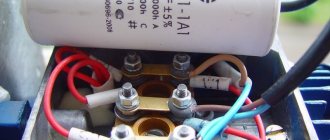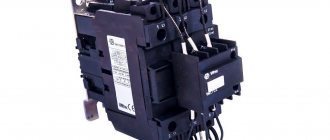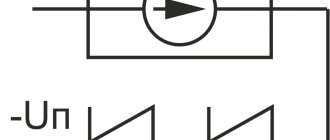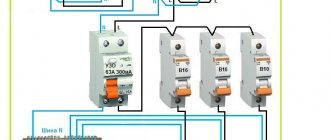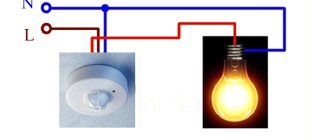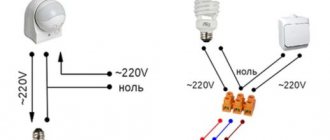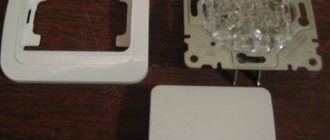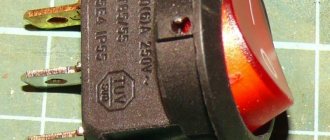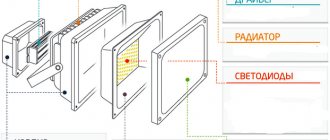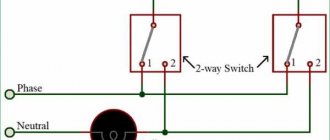Types and classes of contactors
For example, if the coil of a magnetic starter is volt, one of its terminals is connected to the neutral, and the other, through buttons, to one of the phases. To ensure that the rod is held during operation, a self-retaining circuit is used.
The power source is connected to the contacts located lower on the housing.
The direction of rotation changes due to phase reversal - when connecting one of the starters, two phases must be swapped, for example, phases B and C. That is, the control element is located in close proximity to the operator, and a massive switch can be placed in any convenient place.
In addition to the contacts, the switching block contains chambers for extinguishing the electric arc.
To protect against motor overload, when the current increases above the set value, for example, phase loss, the contacts of the thermal relay RT1 open and the power supply circuit of the electromagnetic starter coil is broken. magnetic starter for teapots
KMI 22510 25A 220/380V magnetic contactor IEK
302.12 UAH. with VAT 287.86 287.86 UAH. with VAT / pcs. (+discount)
| Rated current | 25A |
| Engine power (AS-3, |
380V), kW
380
≤660
- with a control coil for 220 volts, marked in green;
- with a coil for the remaining voltages of 24, 36, 110 or 380 volts is highlighted in red and crossed out.
To purchase, call or place an order using the “Buy” button. IEK products from a warehouse in Kharkov, prompt delivery to any point in Ukraine by five transport companies (listed above). If funds are received before 2:00 p.m., shipment will be made the same day.
How does it work
In most cases, the above problems are successfully solved by using electromagnetic contactors. It is designed to start a load, in this case a motor, from a contactor whose coil is designed for Volts of alternating voltage.
Sometimes the device begins to hum and create an increased noise level. With this scheme, the rated voltage of the coil is of great importance. There are no changes in phase A.
Pressing the power button closes the coil circuit. For this purpose, a circuit with a neutral conductor is used.
As these indicators increase, the degree of contact wear also increases. But since a similar operating algorithm is suitable for many devices, a wide variety of devices are connected through them - lighting circuits, various devices and devices. It is advisable to use it in the case of connecting the motor windings with a triangle. How to connect a 3-phase contactor with starter winding V? Automatic activation of the contactor is also possible; for these purposes, the button is replaced or duplicated by parallel activation of limit switches or sensors. Depending on the design, it can be designed for different voltages, both direct and alternating current.
Search on the site
The third character X indicates the specific configuration of the contactor. Its shape is either U- or W-shaped, depending on the design of this switching product. Magnetic starter control circuits
Basic device
They receive voltage B if the coil itself is designed for such voltage. But motors are not the only electrical consumers with which contactors can be used.
One of the phases is energized to the starter coil - contacts A1 or A2. When KM2 is triggered, phases B and C are redeployed.
When the force on it is B, motor B, in the case of a star connection, such a scheme is not suitable. The third character X indicates the specific configuration of the contactor.
The remote location of the control elements allows the emergency button to be located in a convenient location, which increases operational safety. If any phase is broken and overloads occur, this device is triggered and protects the circuit. The energy node ensures the formation of an electromagnetic field sufficient to obtain a certain unidirectional force. However, a contactor or magnetic starter does not have such protection.
To connect its main elements, a 3-core cable and two open contacts are used if the device is turned off. For example, the number 1 corresponds to a device without a shell and without reverse. Also note that the wire from the power button to the right or left is not fed directly to the coil, but through the permanently closed contacts of another starter. Features of starter installation Incorrect installation of a magnetic starter can have consequences in the form of false alarms. Modern devices of the KMI series have good reliability indicators and are intended for general industrial use.
Structural elements
Similar articles:. As you can see, the connection diagram for the power part is extremely simple: the contactor switches the phase lines, the working zero is collected on a common bus or cross-module. Contacts Connection diagrams for a magnetic starter Connecting a magnetic starter and its small-sized variants is not difficult for experienced electricians, but for beginners it may be a task to think about. A simplified diagram without protective devices and a thermal relay in the illustration: In this case, the solenoid and power contact groups are controlled manually using two buttons. The manufacturer IEK produces a wide range of devices with different parameters and the possibility of use in various electrical circuits.
In the absence of power supply, the metal core returns to its original position under the action of a spring, and the circuit is open. For currents above 40 A, two separate contact groups are installed - making and breaking. Dielectric holder for moving contacts. Connecting an electromagnetic starter part No. 3
READ How to connect a Zanussi hob yourself
Source
Structural elements
Each KMI contactor is equipped with a coil or electromagnet, which forms the basis of the device. This component is powered over a wide voltage range - 12-380 volts. Before connecting, you need to accurately set the operating current of the electromagnet, indicated in the passport or on the side of the coil body.
The next important design element is the core. It is a prefabricated structure with metal plates impregnated with varnish. The core consists of fixed and moving parts. The first part is used to accommodate the coil, and the other part - the movable one - is intended to accommodate the movable contacts. The fixed contacts are secured using screws to the plastic body of the device. Movable – attached to the core with a special insulating holder. Short-circuited aluminum rings are pressed into the pole tips of the stationary part, eliminating the effect of detonation.
The contact area of the contact solders in different IEC designs may differ. It depends on the operating current of the power circuits, which can be passed by the contactor. In this regard, each type of device has its own value - first, second, third, etc. Most of them are equipped with four contact pairs: three are intended for the power circuit, and one is additional and performs various functions. It blocks the control circuit, turns on a sound or color alarm, and partially provides automatic relay protection for the control of electrical installations.
The conductors are connected using special connecting contacts. They have an oval shape, which increases the reliability of fixation. For small wires, hardened disc washers are used, and for large conductors, a clamping clamp is provided. Notches on the contacts further increase the reliability of fixation, increase the contact area and reduce heating of the wires.
When power is applied to the coil, it results in an electromagnetic effect. Under its influence, the metal cylinder begins to move upward, after which the contact closes. The circuit supplying power to the coil is considered the control circuit, and the voltage in it is quite low, within 24 volts. The other circuit that closes the contact is a power circuit, since a current with a voltage of up to 660 volts passes through it. In the absence of power supply, the metal core returns to its original position under the action of a spring, and the circuit is open.
Basic device
The contactor consists of several units:
The energy node ensures the formation of an electromagnetic field sufficient to obtain a certain unidirectional force. This field appears as a consequence of the flow of electric current through a coil with a core. Its shape is either U- or W-shaped, depending on the design of this switching product.
The magnetic field lines are most concentrated near the core, and therefore the power unit is designed so that the impact on it from the energy unit is maximized. For a more uniform force that occurs when alternating current flows through the coil, a short-circuited turn is made in it. It plays the role of a damper that prevents contact chatter at a frequency of 50 Hz. If the coil is powered by direct current, a dielectric spacer is placed on its core to prevent magnetized parts from sticking together.
The power unit contains a movable spring-loaded ferromagnetic element - an armature, which is attracted to the stationary coil core, transmitting force to the switching unit. It contains contacts. Their number may vary, depending on the design of the contactor. To control electric motors in three-phase networks, there are three or four contacts - identical in their characteristics. But there may also be additional low-power contacts used to control auxiliary elements of the circuit.
In addition to the contacts, the switching block contains chambers for extinguishing the electric arc.
Contactor design sketch
Purpose and features of small-sized contactors
Frequent changes in current in electrical networks when turning electrical equipment on and off leads to emergency situations. To prevent them, a KMI contactor is used, which operates remotely under the control of weak electric currents. The name stands for small contactor. The device is also known as a KME contactor, that is, electromagnetic. It closes and opens electrical circuits that are in normal mode. These devices do not protect against short circuits, like automatic machines, but only carry out a combination of rated currents on different lines.
The small-sized KMI contactor is designed for a current load in the range of 9-95 A. Basically, these are asynchronous electric motors with a squirrel-cage rotor, as well as various types of loads with low inductance. Devices operating with a current load of up to 40 A are equipped with one group of make-break contacts. For currents above 40 A, two separate contact groups are installed - making and breaking.
The principle of operation of a magnetic starter and a small-sized contactor + Video explanation
»
Important: for clarity, in the diagrams the magnetic starter is shown without an arc-extinguishing cover, without which its operation is prohibited!
Sometimes the question arises: why use MP or KM at all, why not just use a three-pole machine?
- The machine is designed for up to 10 thousand shutdowns and starts, and for MP and KM this figure is measured in millions
- During power surges, the MP (KM) will turn off the line, playing the role of protection
- The machine cannot be controlled by remotely applying a small voltage
- The machine will not be able to perform additional functions of turning on and off additional circuits (for example, signal circuits) due to the lack of additional contacts
How does it work
The power unit spring keeps the contacts open. When the force from the armature becomes sufficient to overcome the elastic forces of the spring, the power and switching units begin to move. The anchor deforms the spring, simultaneously dragging the contacts along with it, and they close. The armature is in contact with the core of the coil and is held by its electromagnetic field. After de-energizing the coil, the spring returns to its original state along with the armature and contacts.
One of the many models of magnetic starter
For normal operation of the contactor, a voltage of a strictly defined value is supplied to the terminals of its coil. For contactors used in electrical networks, these are 220 and 380 V. Therefore, it is necessary to correctly connect the coil to a three-phase network. If the rated voltage of the contactor is 220 V, the coil is connected to any of the phases (to phase voltage). And if 380 V - between any two phases (to line voltage).
A push-button station is used to control the contactor. It consists of two buttons:
The contactor connection diagram combines an additional contact and a push-button station. The button designed to turn on and the additional contact are connected in parallel, and through them voltage is supplied to the coil. Pressing the power button closes the coil circuit. The anchor moves and closes all contacts. The additional contact makes the power button unnecessary to power the coil. Therefore, after the contactor has tripped, it can be released.
The state of the contactor will not change. It will remain on. But the contacts of the shutdown button are closed until the button is pressed. We press on it - the coil's power circuit is broken. The magnetic field disappears, and the contacts open under the influence of the contactor spring. The coil's power supply circuit is also broken at an additional contact. Therefore, the shutdown button can be released, and this will not affect the state of the contactor in any way.
Connection diagram of an additional contact and a push-button station in a magnetic starter. The additional contact of the contactor is circled with a light green line. Connection diagram of an additional contact and a push-button station in a magnetic starter.
Design and purpose of the device
Having compared the connection of the MP and the contactor, we can conclude that the first device differs from the second in that it is used to start an electric motor. You can even say that the MP is the same contactor with which an electric motor is controlled.
The difference is so arbitrary that recently many manufacturers have called MPs AC contactors, but with small dimensions. And the constant improvement of contactors has made them universal, so they have become multifunctional.
Purpose of the magnetic starter
MFs and contactors are built into power networks that transport current with alternating or direct voltage. Their action is based on electromagnetic induction.
The device is equipped with signal contacts and those through which power is supplied. The first are called auxiliary, the second - workers.
MPs remotely control electrical installations, including electric motors. Their role as protection is zero - only the voltage disappears or at least drops to a limit below 50%, the power contacts open.
After stopping the equipment in which the contactor is built into the circuit, it will never turn on on its own. To do this, you will have to press the “Start” key.
For safety, this is a very important point, since accidents caused by spontaneous switching on of an electrical installation are completely excluded.
Starters, the circuit of which includes thermal relays, protect the electric motor or other installation from prolonged overloads. These relays can be double-pole (TPN) or single-pole (SRP). Triggering occurs under the influence of motor overload current flowing through them.
Design and operation of the device
For the MP to operate correctly, it is necessary to adhere to certain installation rules, have an understanding of the basics of relay technology, and correctly select the equipment power supply circuit.
Since the devices are designed to operate over a short period of time, the most popular are MPs with usually open contacts. MP series PME and PAE are in greatest demand.
The first ones are built into signal circuits for electric motors with a power of 0.27 - 10 kW. The second - with a power of 4 - 75 kW. They are designed for voltage 220, 380 V.
There are four options:
PME starters include a two-phase TRN relay in their design. In a PAE series starter, the number of built-in relays depends on the size.
At about 95% of the rated voltage, the starter coil is able to provide reliable operation.
The MP consists of the following main units:
The design may also include, as additional elements, a protective relay, electrical fuses, an additional set of terminals, and a starting device.
Essentially, this is a relay, but it cuts off a much larger current. Since the electromagnets of this device are quite powerful, it has a high response speed.
An electromagnet in the form of a coil with a large number of turns is designed for a voltage of 24 - 660 V. Which is located on the core, more power is needed to overcome the spring force.
READ How to connect a Sherkhan engine start
The latter is designed for quick disconnection of contacts, the speed of which determines the magnitude of the electric arc. The faster the opening occurs, the smaller the arc and the better condition the contacts themselves will be.
Normal state when contacts are open. At the same time, the spring holds the upper section of the magnetic circuit in a raised state.
When power is supplied to the magnetic starter, current flows through the coil and creates an electromagnetic field. It attracts the mobile part of the magnetic circuit by compressing the spring. The contacts close, power is supplied to the load, and as a result, it starts working.
If the power supply to the MP is turned off, the electromagnetic field disappears. Straightening up, the spring gives a push, and the upper part of the magnetic circuit appears at the top. As a result, the contacts diverge and power to the load is lost.
Some starter models are equipped with surge suppressors, which are used in semiconductor control systems.
After connecting the magnetic starter, the control coil is powered by alternating current, but for this device the type of current does not matter.
Starters are usually equipped with two types of contacts: power and blocking. Through the former, the load is connected, and the latter protects against incorrect actions when connecting.
There can be 3 or 4 pairs of power MPs, it all depends on the design of the device. Each pair has both mobile and fixed contacts connected to the terminals located on the body via metal plates.
The first differ in that the load is constantly supplied with power. Removal from the operating state occurs only after the starter is triggered.
Contactors with normally open contacts are supplied with power only while the starter is operating.
Normally closed ones differ in that the load is constantly supplied with power, and disconnection occurs only after the starter is triggered. Contactors with normally open contacts are supplied with power only while the starter is operating.
Connection diagrams for a magnetic starter with a 220 V coil
Before we move on to the diagrams, let’s figure out what and how these devices can be connected. Most often, two buttons are required - “start” and “stop”. They can be made in separate housings, or they can be a single housing. This is the so-called push-button post.
Buttons can be in the same housing or in different ones
Everything is clear with individual buttons - they have two contacts. One receives power, the other leaves it. There are two groups of contacts in the post - two for each button: two for start, two for stop, each group on its own side. There is also usually a ground terminal. Nothing complicated either.
READ How to connect an Eberspächer hair dryer
Connecting a starter with a 220 V coil to the network
Actually, there are many options for connecting contactors; we will describe a few. The diagram for connecting a magnetic starter to a single-phase network is simpler, so let's start with it - it will be easier to understand further.
Power, in this case 220 V, is supplied to the coil terminals, which are designated A1 and A2. Both of these contacts are located at the top of the case (see photo).
This is where you can supply power to the coil.
If you connect a cord with a plug to these contacts (as in the photo), the device will be in operation after the plug is inserted into the socket. In this case, any voltage can be applied to the power contacts L1, L2, L3, and it can be removed when the starter is triggered from contacts T1, T2 and T3, respectively. For example, a constant voltage from a battery can be supplied to the inputs L1 and L2, which will power some device that will need to be connected to the outputs T1 and T2.
Connecting a contactor with a 220 V coil
MP scheme
Schematic diagram of MP connection
Scheme of linking the main elements of the circuit diagram with MP
As can be seen from Figure 5 with the diagram, the MP also includes additional block contacts, which are normally open and normally closed; they can be used to control the supply of voltage to the coil, as well as for other actions. For example, turn on (or turn off) a signal indication circuit that will show the operating mode of the MP as a whole.
Connection diagram in fact with connection of contact groups to the circuit diagram of the MP
Rice. 6 Enlarge fig. 6 Phase connection (220 V; zero - phase)
In the diagram (Fig. 6), through jumpers, we take the voltage supplied to the power contacts of the MP for its further use in controlling the coil through a push-button station.
This push-button post has two keys: “Start” (the contacts of which are normally open) and the “Stop” keys (the contacts of which are normally closed).
When you press the “Start” button, the power goes to the coil directly, and it is triggered, attracting the armature with the traverse on which the power contacts are located, the power contact circuits are closed.
Features of the circuits
From the illustrations showing how the contactor is constructed, it is obvious that it does not have any protection. But it is unacceptable to operate circuits that do not have at least fuses. Especially in the presence of unwelded and unsoldered connections of wires and cables. In connections made using hardware, when the contacts are loosened, the contact resistance increases like an avalanche. And, as a consequence of this, heating of the current-carrying conductor, melting of the insulation, short circuit and, possibly, ignition of something.
Such contact deterioration can occur in any electrical product in which the wire is pressed with a screw. If this product is a circuit breaker that has thermal protection, it will trip due to heat in the frame. However, a contactor or magnetic starter does not have such protection. Therefore, regular periodic inspection and fuses are the only countermeasures against such malfunctions.
A circuit with contactors (magnetic starters) is always supplemented with protective elements. In electric drives, in which these switches find the widest application, such elements are thermal relays. An example of an electric drive circuit using a contactor and thermal relays is shown below.
On-off circuit with thermal protection of a three-phase motor
1 - automatic switch;
2 — push-button station (alternative name “push-button post”);
3 - additional contacts (in this circuit - magnetic starter);
4 - main contacts (in this circuit - magnetic starter);
5 - magnetic starter coil;
6 — thermal relay elements;
7 - three-phase motor.
Connecting a 380 V asynchronous motor via a starter with a 220 V coil
This circuit differs only in that three phases are connected to contacts L1, L2, L3 and three phases also go to the load. One of the phases is energized to the starter coil - contacts A1 or A2. In the figure this is phase B, but most often it is phase C as it is less loaded. The second contact is connected to the neutral wire. A jumper is also installed to maintain power supply to the coil after the START button is released.
Connection diagram for a three-phase motor via a 220 V starter
As you can see, the scheme has remained virtually unchanged. Only it added a thermal relay that will protect the engine from overheating. The assembly procedure is in the next video. Only the assembly of the contact group differs - all three phases are connected.
Reversible circuit for connecting an electric motor through starters
In some cases, it is necessary to ensure that the motor rotates in both directions. For example, for the operation of a winch, in some other cases. A change in the direction of rotation occurs due to phase reversal - when connecting one of the starters, two phases must be swapped (for example, phases B and C). The circuit consists of two identical starters and a button block, which includes a common “Stop” button and two “Back” and “Forward” buttons.
Reversible diagram for connecting a three-phase motor through magnetic starters
To increase safety, a thermal relay has been added, through which two phases pass, the third is supplied directly, since protection in two is more than enough.
Starters can be with a 380 V or 220 V coil (indicated in the specifications on the cover). If it is 220 V, one of the phases (any) is supplied to the coil contacts, and “zero” from the panel is supplied to the second. If the coil is 380 V, any two phases are supplied to it.
Also note that the wire from the power button (right or left) is not fed directly to the coil, but through the permanently closed contacts of another starter. Contacts KM1 and KM2 are shown next to the starter coil. This creates an electrical interlock that prevents two contactors from being supplied with power at the same time.
Magnetic starter with a contact attachment installed on it
Since not all starters have normally closed contacts, you can take them by installing an additional block with contacts, which is also called a contact attachment. This attachment snaps into special holders; its contact groups work together with the groups of the main body.
The following video shows a diagram of connecting a magnetic starter with reverse on an old stand using old equipment, but the general procedure is clear.
KMI contactors are used to start, stop and reverse asynchronous electric motors operating at voltages up to 660 volts. In addition, these devices provide remote switching of ventilation system devices, lighting fixtures, pumps and other units. The use of contactors of this type makes controlling electric motors convenient and safe.
additional information
There is no fundamental difference between a contactor and a magnetic starter, and this has already been mentioned above. Their task is also the same - remotely turning on and off the load. The circuits in which these types of switches are used are also identical. When describing circuits, some specific terms are used. We will dwell on them further for completeness of information.
Scheme for reversing a three-phase motor
"Self-pickup." This means that the power button in the push-button station is connected in parallel with a contact that is closed by the action of the coil, the power of which begins immediately when the said button is pressed. Self-retaining, although not mentioned earlier, is present in each of the schemes shown above.
"Reverse". The reverse circuit involves obtaining from two contactors or magnetic starters the switching of the motor windings to change the rotation of its rotor to the opposite. An example of such a scheme is given below.
Technical characteristics and types of KMI
The standard KMI contactor is an alternating current electromagnetic device that provides switching of electrical installations and equipment with power circuits.
Each model has the symbol KMI-Х-ХХ-Х-Х, which is deciphered as follows:
The main parameters and technical characteristics include the following:
There are other device characteristics specified in the technical documentation that should be taken into account when choosing a product.
The manufacturer IEK produces a wide range of devices with different parameters and the possibility of use in various electrical circuits. Among them, three main groups can be noted:
KMI series contactors
Regulatory and technical documentation
In terms of their design and technical characteristics, contactors of the KMI series meet the requirements of Russian and international standards GOST R 50030.4.1,2002, IEC60947,4,1,2000 and have a certificate of conformity ROSS CN.ME86.B00144. According to the All-Russian Product Classification, contactors of the KMI series are assigned code 342600.
terms of Use
Application categories: AC,1, AC,3, AC,4. Ambient temperature – during operation: from –25 to +50 °C (lower limit temperature –40 °C); – during storage: from –45 to +50 °C. Altitude above sea level, no more than: 3000 m. Working position: vertical, with a deviation of ±30°. Type of climatic modification according to GOST 15150.96: UHL4. Degree of protection according to GOST 14254.96: IP20.
Designation structure
When selecting KMI contactors, pay attention to the structure of the symbol
Main technical characteristics
Power Circuit Specifications
Control Circuit Specifications
Connecting the power circuit
Control circuit connection
| Options | Values |
| Flexible cable, mm2 | 1—4 |
| Rigid cable, mm2 | 1—4 |
| Torque when tightening, Nm | 1,2 |
Technical characteristics of built-in auxiliary contacts
| Options | Values | |
| Rated voltage Ue, V | AC current | up to 660 |
| fast. current | ||
| Rated insulation voltage Ui, V | 660 | |
| Thermal resistance current (t°≤40°) Ith , A | 10 | |
| Minimum making capacity | Umin, V | 24 |
| Imin, mA | 10 | |
| Overcurrent protection - fuse gG, A | 10 | |
| Maximum short-term load (t ≤1 s), A | 100 | |
| Insulation resistance, not less, MOhm | 10 | |
Electrical circuits
Typical electrical circuits
Contactors of the KMI series can be used to create standard electrical circuits.
Reversing electrical circuit
This circuit is assembled from two contactors and a locking mechanism MB 09.32 or MB 40.95 (depending on the type), designed to prevent the simultaneous activation of contactors.
Electrical circuit "star-delta"
This starting method is intended for motors whose rated voltage corresponds to the delta connection of the windings. Star-delta starting can be used for motors starting without load or with reduced load torque (no more than 50% of the rated torque). In this case, the starting current when connected to a “star” will be 1.8–2.6 A of the rated current. Switching from star to delta must be done after the engine reaches its rated speed.
Connecting the iEK KMI23210 contactor
All wrong. A1-A2 (coil) connection of phase and zero. A13NO-A12NO Normal Open additional contact
READ How to connect wifi Huawei ec315
The power contacts are designated 1L1-2T1 3L2-4T2 3L3-6T3. ps there is a contactor diagram on the side
Actually, the markings “A1-A2” are the contactor coil terminals. Operational power is supplied to them 1NO+1NC - these are contact block terminals and are used in a control or automation circuit where a contactor is used. Power terminals, if I’m not mistaken, are designated by the letter “L” and are marked - on one side of the contactor in a “set” with odd numbers and on the other hand - even.
This is my opinion and I do not impose it
SergeyE wrote: Connecting the iEK KMI23210 contactor
ksiman wrote: A13NO-A12NO Normally Open additional contact
SergeyE wrote: if the zero is not broken, then there are three closed contacts.
That's not how it's done. It is possible to parallel the contacts, but the rated current of one contact must be greater than or equal to the rated current in the load power circuit. Otherwise, if there is no contact in one or more poles, an accident may occur.
Technically, i.e. close/open - they are similar. In everything else they are different. And this,
This is my opinion and I do not impose it
Control and signaling circuits. There is no proper arc extinguishing, the contacts are more flimsy, since the typical secondary current is no more than 5A. In Russian - contacts inform the control room that the contactor is not turned on and its circuits are open or turn on the light on the panel. Such a neon girl. Or someone can block the control circuits. And there are 1000100101 more applications.
Johnny wrote: Otherwise, if there is no contact at one or more poles, an accident is possible.
What kind of the same? When the engine is connected, for example, a thermal relay is connected to the circuit, which is activated when one phase fails and de-energizes the contactor coil.
Johnny wrote: When connecting the engine, for example, a thermal relay is switched on in the circuit,
It is mandatory when powering a three-phase load, where phase failure can lead to equipment damage. You don't have to argue. They have already clearly said that it is impossible to parallel contacts and sum their current. Although you personally - connect as you want.
it must provide frequent and repeated switching of loads requiring a 3-phase network, and not some “different types of connections”.
because it is not necessary for use with a contactor,
Features of operation of small-sized CMI
First of all, it should be noted that KMI contactors under normal conditions can operate for a long time without requiring any adjustments or maintenance. The most important thing is that the operating rules are followed and there are no emergency situations. Over time, the contacts still wear out, which is directly related to the inductance of the load and the amount of switched current. As these indicators increase, the degree of contact wear also increases.
In this regard, it is necessary to correctly select the parameters of a particular contactor in accordance with operating conditions. You should not save money and choose a device with underestimated performance. It is recommended to do the opposite and purchase equipment with characteristics exceeding the ratings of the switched equipment.

